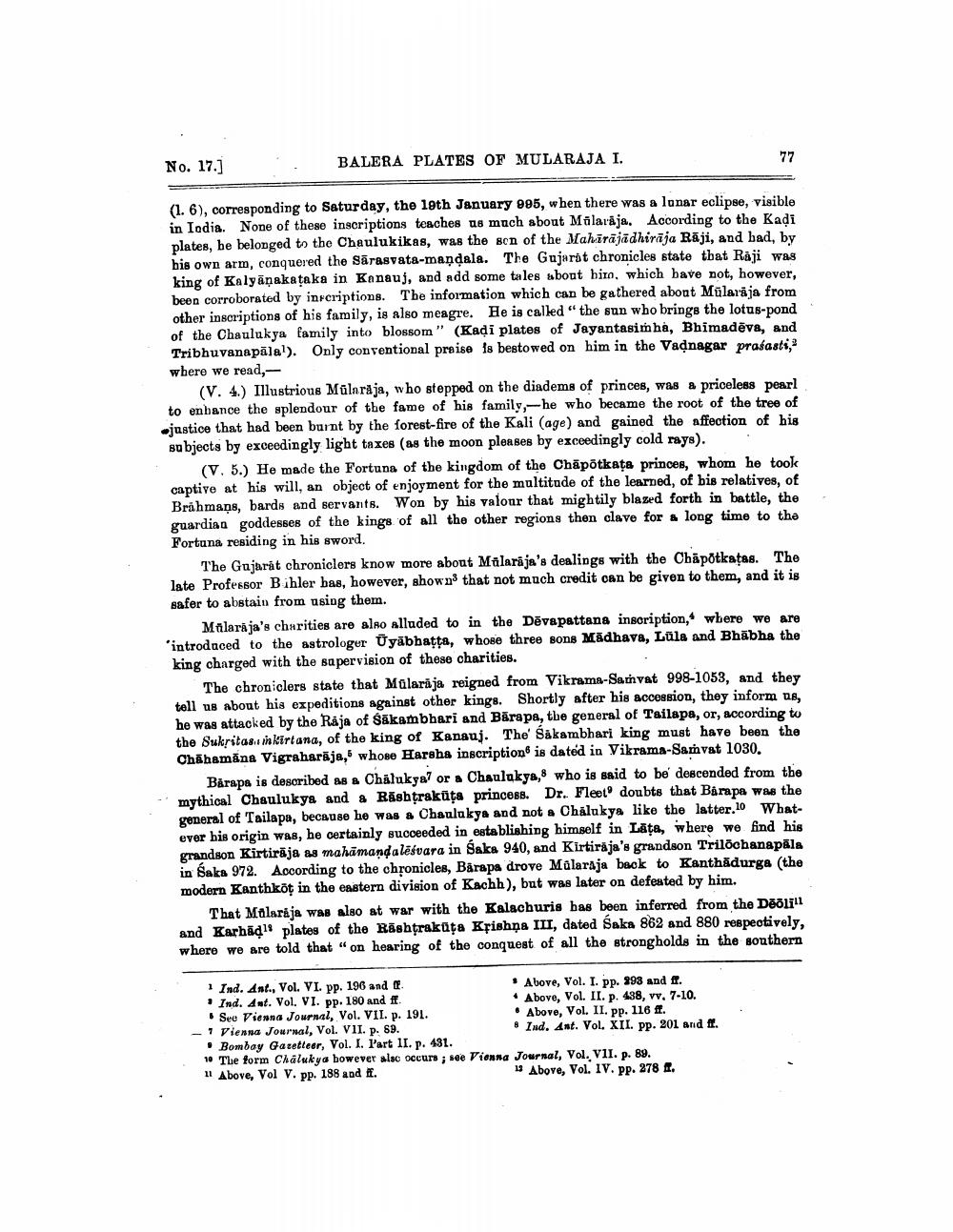________________
No. 17.)
BALERA PLATES OF MULARAJA I.
(1. 6), corresponding to Saturday, the 19th January 995, when there was a lunar eclipse, visible in Iodia. None of these inscriptions teaches as much about Mälarája. According to the Kadi plates, he belonged to the Chaulukikas, was the son of the Mahīrājādhiraja Rāji, and bad, by his own arm, conquered the Sārasvata-mandala. The Gujarat chronicles state that Raji was king of Kalyāņakataka in Kanauj, and add some tales about hiro, which bave not, however, been corroborated by infcriptions. The information which can be gathered about Mülaraja from other inscriptions of his family, is also meagre. He is called "the sun who brings the lotus-pond of the Chaulukya family into blossom" (Kadi plates of Jayantasimha, Bhimadēvs, and Tribhuvanapāla!). Only conventional preise fs bestowed on him in the Vadnagar prasasti, where we read, -
(V. 4.) Illustrious Mülnraja, who stepped on the diadems of princes, was a priceless pearl to enbance the splendour of the fame of his family,-- he who became the root of the tree of ejustice that had been burnt by the forest-fire of the Kali (age) and gained the affection of his subjects by exceedingly light taxes (as the moon pleases by exceedingly cold rays).
(V. 5.) He made the Fortune of the kingdom of the Chāpotkața princes, whom he took captive at his will, an object of enjoyment for the multitude of the learned, of bis relatives, of Brühmans, bards and servants. Won by his valour that mightily blazed forth in battle, the guardian goddesses of the kings of all the other regions then clave for a long time to the Fortuna residing in his sword.
The Gujarat chroniclers know more about Mälarāja's dealings with the Chäpotkatas. The late Professor Bihler bas, however, shown that not much credit can be given to them, and it is safer to abstain from using them.
Mälaraja's charities are also alluded to in the Dēvapattana inscription, where we are 'introdaced to the astrologer Ūyābbatta, whose three sons Madhava, Lüla and Bhābha the king charged with the supervision of these charities.
The chroniclers state that Malarāja reigned from Vikrama-Samvat 998-1053, and they tell us about his expeditions against other kings. Shortly after his accession, they inform us, he was attacked by the Raja of Sakambhari and Bārapa, the general of Tailapa, or, according to the Sukritas sikirtana, of the king of Kanauj. The Sakambhari king must have been the Chākamāna Vigraharāja, whose Harsha inscription is dated in Vikrama-Samvat 1030.
Bärapa is described as a Chalukya7 or a Chaulukya, who is said to be descended from the mythical Chaulukys and & Rashtrakūta princess. Dr. Fleet' doubts that Barapa was the general of Tailapa, because he was a Chaulukya and not a Chalukys like the latter.10 Whatever his origin was, he certainly succeeded in establishing himself in Lata, where we find his grandson Kirtirāja as mahāmandalesvara in Saka 940, and Kirtiraja's grandson Trilochanapala in Saka 972. According to the chronicles, Barapa drove Malaraja back to Kanthadurga (the modern Kanthköt in the eastern division of Kachh), but was later on defeated by him.
That Molarăja was also at war with the Kalachuris bas been inferred from the Deðlill and Karhādi plates of the Rashtrakūta Krishna III, dated Saka 862 and 880 respectively, where we are told that “on hearing of the conquest of all the strongholds in the southern
1 Ind. Ant., Vol. VI. pp. 196 and if
• Above, Vol. I. pp. 993 and ff. Ind. Ant. Vol. VI. pp. 180 and ff.
* Above, Vol. II. p. 438, vv. 7-10. See Vienna Journal, Vol. VII. p. 191.
• Above, Vol. II, pp. 116 ff. - 1 Vienna Journal, Vol. VII. p. 89.
• Ind. Ant. Vol. XII. Pp. 201 and it. . Bombay Gazetteer, Vol. I. Part II. p. 431. 16 The form Chalukya bowever slac occurs; see Vienna Journal, Vol. VII. p. 89. 11 Above, Vol V. pp. 188 and f.
1 Above, Vol. IV. pp. 278 .




